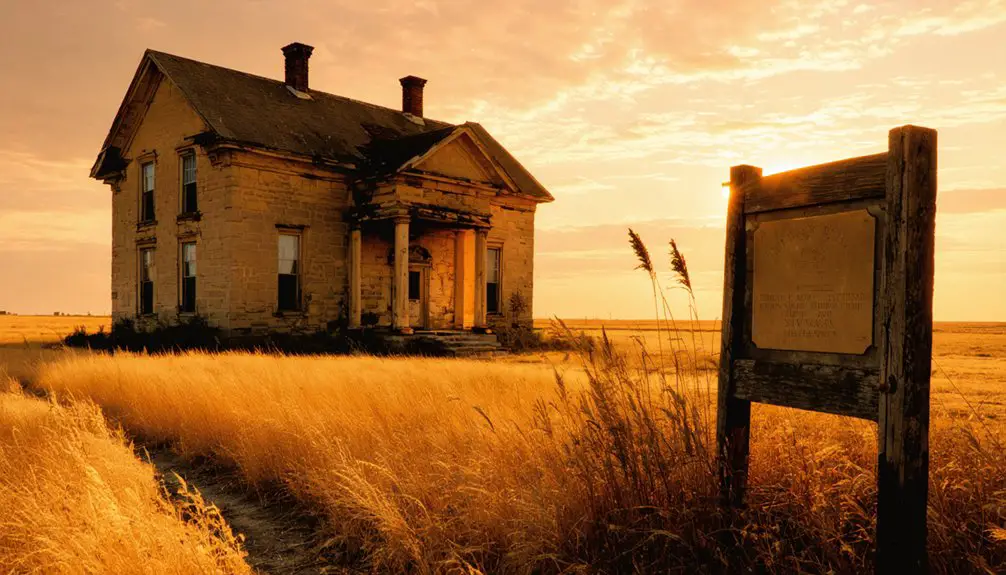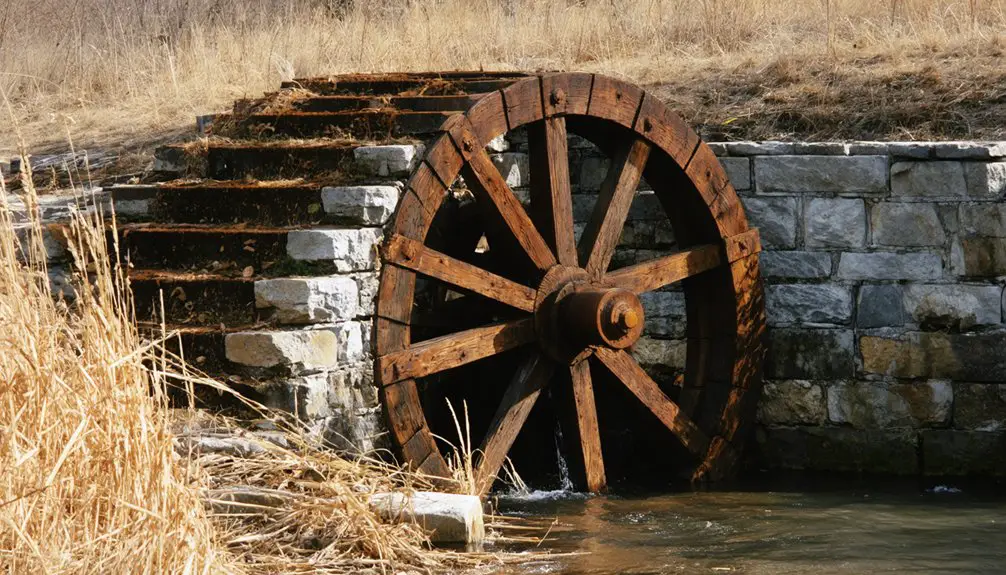You’ll find 110 Mile Creek’s ghost town at a historic Santa Fe Trail crossing where McGee’s Tavern once thrived as an essential frontier hub. During the 1850s, this strategic location featured a profitable toll bridge, trading post, and one of only sixteen voting places in Kansas Territory. The site’s dramatic decline came amid “Bleeding Kansas” violence, though its preserved landmarks and cemetery still whisper tales of frontier dreams and conflicts.
Key Takeaways
- 110 Mile Creek became a ghost town after escalating violence during “Bleeding Kansas” forced businesses to close and settlers to abandon homes.
- McGee’s Tavern, once a bustling trading hub with accommodations and supplies, was deserted due to regional conflicts in the 1850s.
- The area’s decline from prosperous crossing point to ghost town stemmed from increased lawlessness and safety concerns for settlers.
- Historic landmarks, including an overhead railroad bridge and McGee’s toll bridge, remain as remnants of the abandoned settlement.
- The William M. Mills House and a small family cemetery with 1800s headstones preserve the ghost town’s historical significance.
Early Origins and Trail Significance
The strategic crossing at 110 Mile Creek emerged as an essential waypoint on the Santa Fe Trail during the 1825-1827 survey expedition, when surveyors measured its distance from Fort Osage, Missouri.
You’ll find this location was originally known as Jones Creek before its distance-based rename became critical for trail navigation.
The creek’s significance grew from its natural ford, where Shawnee Indians had established a small settlement.
Their indigenous heritage shaped the area’s early development, as two tribal-connected settlers operated profitable toll crossings. In 1854, Fry and Mobillion McGee purchased the land and established a successful inn and toll bridge operation.
The site gained notoriety after a tragic wagon train incident nearby, where a blizzard claimed numerous oxen – their bleached bones serving as a somber landmark for years.
This crossing point’s reliability made it indispensable for traders and travelers, cementing its place in Santa Fe Trail history.
Border ruffians frequently disrupted travel along this section of the trail during the tumultuous period of 1856.
McGee’s Tavern and Trading Hub
Standing as an essential frontier establishment, McGee’s Tavern emerged in 1854 when Fry McGee constructed a sprawling lodge of native walnut and oak at the strategic 110 Mile Creek crossing.
The tavern architecture featured four distinct rooms with massive fireplaces at each end, accommodating both single travelers and families. For just $1 per night and 50 cents per meal, you’d find comfort on buffalo robes near the hearth. Twice monthly, the tavern welcomed a mail service coach carrying both correspondence and passengers. The establishment gained notoriety as one of only sixteen voting places in the Kansas Territory.
McGee’s trading practices extended beyond basic lodging. You’d discover a bustling hub of commerce, complete with a blacksmith shop, general store, and extensive barn facilities.
McGee’s Tavern thrived as more than a simple inn, offering travelers a one-stop frontier marketplace for trade, repairs and supplies.
The establishment served multiple roles – from selling whiskey and merchandise to providing wagon repairs. A toll bridge crossing brought in up to $30 daily during peak seasons, while the property’s 70 acres supported various outbuildings essential to frontier commerce.
Native American Relations and Settlement
You’ll find that 110 Mile Creek’s early development was shaped by Shawnee mixed-blood families who established farms and trading operations along the Santa Fe Trail by 1854.
Richardson and other Shawnee-connected entrepreneurs ran a profitable toll crossing business that served both Native American and white travelers before selling their interests to the McGee brothers.
These mixed-heritage landholders, who’d married into the Shawnee tribe, played an essential role in bridging Native American and settler commerce during the area’s shift from Indigenous territory to white settlement.
In August 1854, Mobillion McGee took over operations by establishing McGee’s Crossing at the site.
The area later attracted settlers seeking to establish Free State ideals as tensions grew between pro-slavery and anti-slavery factions.
Shawnee Mixed-Blood Families
During the early settlement period of 110 Mile Creek, mixed-blood Shawnee families played a pivotal role as cultural intermediaries between native and Euro-American societies.
You’ll find that these families, often descended from intermarriages with Miami, Delaware, and Wyandotte tribes, established themselves as essential bridges between cultures. Their mixed-blood identity enabled them to navigate both traditional Shawnee ways and Euro-American customs effectively. Speaking the Algonquian language family allowed them to maintain strong connections with their indigenous roots. William Jackson Fish exemplified this heritage through his adoption by Chief Black Fish before 1778.
Notable leaders like Pi-sã-‘k (Jackson Fish) and Joseph Parks demonstrated this cultural flexibility through their involvement in U.S. military service while maintaining tribal connections.
Many received education at Shawnee Mission, where they learned English and trades, further strengthening their ability to move between worlds. Their presence near Turner and Wyandotte County helped shape the region’s early development through their unique position as cultural intermediaries.
Early Trading Relations
Before becoming a bustling frontier settlement, 110 Mile Creek served as an essential Shawnee trading post where native merchants and travelers regularly crossed the Santa Fe Trail.
The creek’s strategic location fostered dynamic trade relations between Shawnee traders and passing settlers, with cultural exchanges centered around furs, food, and tools at the natural ford crossing.
A Shawnee man named Richardson, who’d married into the tribe, operated a profitable toll crossing that exemplified the blending of native and settler commerce. Similar to Richardson’s enterprise, Withington’s Store would later become a crucial trading post along the Santa Fe Trail.
You’ll find that these early trade dynamics shaped the region’s development until 1854, when the Shawnee removal forced changes in local commerce.
The McGee family later purchased the crossing from Richardson, transforming the former native trading hub into a new frontier enterprise while maintaining the site’s crucial role in Santa Fe Trail commerce.
Fry McGee established a successful business by charging twenty-five cents for travelers to cross his newly constructed bridge at the creek.
The Boneyard Blizzard Legacy
While many frontier tragedies have faded from memory, the Boneyard Blizzard remains one of Kansas’ most haunting tales from the Santa Fe Trail era.
You’ll find its legacy preserved just four miles west of Overbrook, where a group of traders faced nature’s deadly fury while attempting to reach Westport. Though the men survived by reaching 110 Mile Crossing on foot, their oxen perished in the fierce storm, leaving behind bleached bones that would mark this grim site for years to come.
The Boneyard symbolism echoes through time, immortalized by a DAR marker near Highways 56 and 75.
This devastating blizzard’s impacts reached far beyond the immediate loss of livestock – it became a stark reminder of frontier vulnerability and nature’s raw power, cautioning future travelers about the perils of winter commerce along the trail.
Military Presence and Strategic Location

You’ll find remnants of military campsites along 110 Mile Creek where troops regularly staged supplies and rested while protecting the Santa Fe Trail during the 1850s and 1860s.
The strategic ford attracted both Union soldiers and Confederate guerrillas, leading to the construction of defensive earthworks and temporary fortifications near McGee’s Crossing.
The military’s presence transformed the creek area into an essential supply depot and defensive position, complete with ammunition stores and provisions necessary for maintaining control over this critical transportation corridor.
Military Camping and Supplies
Due to its strategic position along the Santa Fe Trail, 110 Mile Creek served as a vital military waypoint during the mid-19th century, particularly after Fort Riley‘s establishment in 1852-53.
You’ll find evidence of military encampments where dragoons and Kansas militia units secured the trail and nearby settlements. The creek’s location, exactly 110 miles from Fort Osage, made it an ideal spot for troops to rest and resupply.
The McGee family’s toll bridge and inn supported both civilian and military supply routes, while nearby facilities like horse barns and sawmills kept the logistics flowing smoothly.
During the Border Wars of the 1850s and the Civil War era, you’d have seen both Union forces and Confederate raiders moving through this strategic corridor, highlighting the creek’s importance in frontier military operations.
Trail Defense Fortifications
The strategic position of 110 Mile Creek demanded robust defensive measures along the Santa Fe Trail during the mid-19th century.
You’ll find that military planners incorporated defensive strategies that utilized the natural terrain and fortifications design common to frontier installations, with thick stone walls built to withstand attacks.
While specific fortifications at 110 Mile Creek aren’t documented, you’d have encountered a network of protection through nearby Fort Riley and military roads.
Guard posts monitored the crossing to secure it from Native American raids and bandits.
McGee’s Crossing, with its toll bridge and inn, served as a civilian infrastructure point that supported both military movements and settler safety.
The site’s proximity to multiple Indian reserves and its position as a critical ford made it essential to the broader military strategy of securing the Santa Fe Trail’s commercial viability.
Violence and Social Upheaval
While settlers sought peaceful homesteading along 110 Mile Creek, violent conflicts between pro-slavery and abolitionist factions turned the area into a flashpoint of “Bleeding Kansas” during the 1850s.
McGee’s Crossing became a hub of pro-slavery sentiment, where Missouri men intimidated abolitionists during territorial elections using color-coded ballots. The social conflict escalated as John Brown’s raiders targeted pro-slavery properties, while Confederate guerrillas later crossed from Missouri to terrorize communities along the Santa Fe Trail.
These lawlessness trends intensified when notorious outlaws like Bill Anderson and Jim Reed launched deadly raids near the creek, burning properties and killing settlers.
The constant threat of violence forced many residents to abandon their homes, leading to the closure of businesses and eventual decline of several settlements in Osage County.
Historic Landmarks and Preservation

Despite the region’s turbulent past of violence and lawlessness, numerous historic landmarks along 110 Mile Creek stand as evidence to its significant role in westward expansion.
You’ll find the impressive 280-foot-long overhead lattice steel railroad bridge, now over 110 years old, spanning the creek along the Landon Nature Trail.
While many original structures have vanished, historic preservation efforts have documented essential sites like McGee’s toll bridge and the Santa Fe Trail crossing.
The area’s cultural heritage lives on through the William M. Mills House, a Queen Anne architectural gem listed on the National Register.
A small family cemetery with late 1800s headstones remains one of the few tangible links to early settlers, though it faces preservation challenges in its remote wildlife refuge setting.
Frequently Asked Questions
What Happened to Mcgee’s Family After the Tavern Closed?
While you might expect clear records, McGee’s family fate remains largely unknown. You won’t find detailed accounts after the tavern’s closure, though regional shifts suggest they likely moved as commerce declined.
Are There Any Remaining Structures From the Original Settlement Today?
You won’t find any remaining buildings from the original settlement today. Instead, you’ll see historical markers commemorating the site’s significance, with only trail ruts and the creek itself still visible.
What Was the Average Daily Traffic Through 110 Mile Crossing?
From dozens to hundreds crossed daily at peak times, varying by season. You’d have seen traffic patterns surge during favorable weather as travelers sought this historically significant crossing along crucial Kansas trade routes.
Did Any Famous Historical Figures Pass Through 110 Mile Creek?
You won’t find many famous travelers at this crossing – while it held historical significance for local settlers and officials like Governor Reeder and Fry McGee, nationally known figures aren’t documented here.
What Natural Resources Were Available Near the Creek for Settlers?
While you might think resources were scarce, you’d find abundant water supply, fertile farming land, timber for building, wildlife for hunting, and stone quarries – everything you’d need for independent frontier living.
References
- https://www.youtube.com/watch?v=8imf9ZEYVSA
- https://www.legendsofamerica.com/ks-santafetrailosco/
- https://legendsofkansas.com/agnes-city-kansas/
- https://www.osageco.org/197/History
- http://www.osagecountyonline.com/archives/36529
- https://theclio.com/entry/189596
- https://legendsofkansas.com/osage-county-kansas/
- https://newsantafetrailer.blogspot.com/2018/09/early-kansas-city-was-influenced-by.html
- https://martincitytelegraph.com/2019/01/21/had-mobillion-mcgee-had-his-way-much-of-kansas-city-would-have-been-in-kansas/
- http://www.kansasheritage.org/research/sft/mcgees-tavern.html



